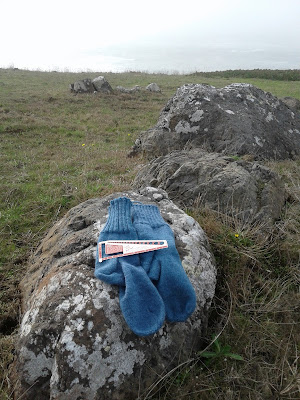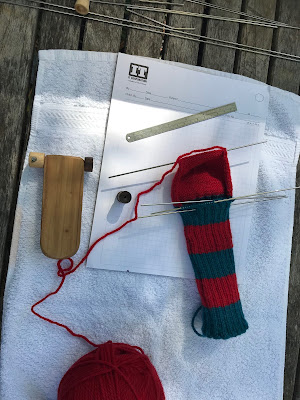With all the news about Russia these days I got to thinking again about Orenburg Lace.
Prices seem to be way down, which tells me things are rough for the knitters over there. $60 for a lace shawl makes spinning/knitting one seem like a waste of time - it is a little like the Merino jumpers I buy at Costco for $50. I cannot knit one for that price, but the Costco jumpers are not like the jumpers I knit. You cannot knit a shawl for the price you can buy one from Orenburg. On the other hand, today the right yarns are hard to find, so you may not be able to knit such shawls at any price. Unless you learn to spin good lace yarn!
Learning to spin good yarn is some effort but it is not impossible.
I have not bought one of those Orenburg, shawls, but I do not think the descriptions are quite accurate. First they claim that the 14 micron goat down is the finest animal product for spinning - not quite - the Guanco I get from Royal Fibers, is also 14 micron. And, 14 micron Merino is available, as is 14 micron cashmere. There are other very fine fibers available.
But, it is not how fine the fiber is, but what one does with it. I buy Rambouillet fleeces from Anna Harvey, (https://www.annagotwool.com/) and after sorting and grading, I get a pound or 2 of 80 count wool fiber out of each fleece. (Plus several pounds of lower spin count wool that can be spun as fine as 35 or 40 thousand yards per pound!) The better graded wool can be spun into singles at ~45,000 yards per pound. It can be spun finer, but spinning finer is much slower and the thread is not as competent. Thus, 2-ply lace yarn can be spun finer than 20,000 yards per pound at a "commercial rate". (And, Anna's wool is spun into tons of such yarn in Italy for fine men's suits.) My hand spinning is very ordinary by Italian commercial standards.
One can spin a single of Rambouillet and ply it with commercial silk, and have a lace yarn that is significantly finer than what is being used these days to produce commercial Orenburg lace. And, I will cheerfully match the luster and softness of high grade Rambouillet against Orenburg down. The Orenburg down yarns are very nice, but they are making marketing claims that are just puff and bluff.
A little research tells us that in the days when there was a lot of royalty around, (and more demand for fine lace) much of the fine Orenburg yarn was spun on "spinning wheels". Art tells us that many of those wheels were likely some kind of vertical charka. That is important because a spinning wheel or charka can put a lot more twist into a yarn, much faster than a supported spindle. I think that these days, Orenburg lace makers use supported spindles due to a combination of lack of capital, lack of work space, and a lack of training. Now, there is no international community of hand spinners to keep a variety of fine spinning traditions and technologies alive. In the past, much hand spinning was devoted to spinning at the wool's spin count, and many people made the required tools These days, nobody is making spinning wheels designed to hand spin wool at its spin count. (The Russian spindles require less craftsmanship.) If my spinning wheel is damaged, there is nobody around that can repair or replace it. That community is gone.
If I did not have my super high speed spinning wheel, and wanted fine lace yarn, I would get a chakra, and mount it vertically to spin woolen singles. Then, I would use a standard flyer and bobbin wheel to ply the final yarn. However, my flyer/bobbin wheel is fast enough to reasonably spin very high twist yarns quickly.
I estimate that the Orenburg down singles are spun at ~ 25,000 ypp, are spun medium firm, and thereby require about 18 or 20 twists per inch. (That is what I put in my 11,200 ypp weaving warp.) While my 44,000 ypp knitting singles require ~ 24 tp.i., or about 30% more twist - that is a huge effort/cost for a craftsman using a supported spindle. A good rule of thumb is that for any spinning operation, the largest cost is energy to insert twist. On the other hand, using a charkha or other high speed spinning wheel, such high twist yarns are much more feasible. If I were asked to produce that style of yarn, I would spin sorted/graded Rambouillet at its spin count (44,000 ypp), then I would ply the single with commercial silk to produce a lace yarn with a grist in the range of 30,000 ypp. I would spin the wool at its spin count because there are real technical advantages to spinning wool at its spin count. There are useful reasons for why wool was graded by its spin count. I do not know if goat down has a measurable spin count.
I do think we should have more spinners that can sit down and spin wool at its spin count. I also think we need better sorted and graded wool. Then people would not be so astonished by the Orenburg lace yarn, and its claims would be more closely examined for truthfulness. There would also be more good yarn around.
The flip side to all of this is that I think the super fine Merino is produced by abusing the sheep, and the finest wool from well treated sheep has a spin count of about 80, meaning it can be reasonably spun into 44,000 ypp singles (20,000 ypp 2-ply, 1,248 yd/oz. or 44.1 yards per gram of 2-ply). Long ago, I put some effort into spinning higher grist yarns, and decided that they had no practical advantages, and many functional disadvantages. I decided that the best display of spinning skill was spinning wool perfectly, at its spin count.
The old hand spinners of Shetland did spin wool at its spin count. Shetland wool has a spin count of 56 to 60, so it was spun at about 33,000 ypp meaning 2-ply Shetland lace yarn at ~14,000 ypp or better, and 3-ply Shetland lace yarn at ~ 9,000 ypp or better. Shetland lace yarn was strong and lustrous. Shetland lace was one of the glories of the Victorian age. Sure it was spun and knit by Shetlanders, but Victorian ladies paid good money to make it possible. We do not see commercial lace yarn of that quality around much these days. I have a bin of wool very much like Shetland next to the wheel that I have been using to spin weaving warp. I can change whorls on my wheel, and be spinning 30,000 ypp singles in minutes. Of course, spinning a useful amount of such singles in a reasonable length of time would involve a change in the fiber prep, but without changing the yarn prep, I could spin a 150 yards of 30,000 ypp singles in a hour. Shetland can be spun at its spin count either worsted or woolen.
These days, I spin fine wools (60 count and higher) woolen, and I spin fiber with a spin count of less than 40 as worsted. This is a real conversion from the rule: "Worsted is the best way to spin". In part, it is a recognition that woolen spinning bends fibers sharply, and finer fibers can tolerate sharper bends better. And, worsted spinning does not bend fibers as sharply, and thicker fibers do not tolerate being bent sharply. In part, it recognition that most "fine" wool has short staples, and is hard to comb, and I do not believe that "carded" wool produces real worsted thread. This is not an iron clad rule as I have a couple of 40 gallon bins of combing "waste" that I am about to card and spin semi-worsted. It is the "shorts" that I combed out of some Romney fleece that produced many miles of worsted spun, 5-ply gansey yarn at 1,000 yards per pound..
Most of those miles of gansey yarn from this fleece were spun before I accelerated the wheel. In those days my wheel ran at a little over 1,000 rpm. These days, it runs more than 3 times faster. Now, the wheel runs fast enough that I can reasonably make 10-ply (5x2) 1,000 ypp gansey yarn. The extra twist in the extra plies gives the yarn more strength, to compensate for the lower quality of the fiber. Some might consider 2-ply 5,600 ypp yarn to be lace weight. No, it is just the basis of some rather coarse sailing gear.today
While sick, I usually spun inside with artificial light. For various reasons, they produced a flat light. Today, I am back, spinning in the sunshine. The fiber is Anna Harvey's Rambouillet. It is a mixed bag of fleece left over from sorting for very fine fiber, so its spin count is only in the low 70s, but it is brilliantly white. It sparkles! Spun woolen near its spin count it, dazzles. As 2-ply lace yarn at ~ 18,000 yyp, it is brilliant. As 3-ply at ~ 12,000 ypp, it is brilliant, durable, and unbelievably soft.
Such yarns can be spun on supported spindles, but it is very tedious. Each inch of the produced yarn requires between 70 and 110 twists (singles + ply twist). High speed twist makes it much easier to draft these yarns. Fine woolen yarns are better produced on a chakra, or a very high speed DRS controlled bobbin/flyer assembly.














.jpg)